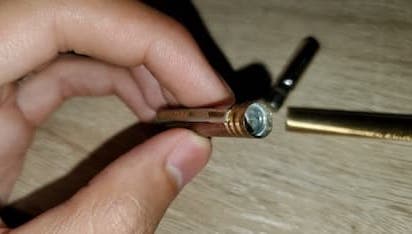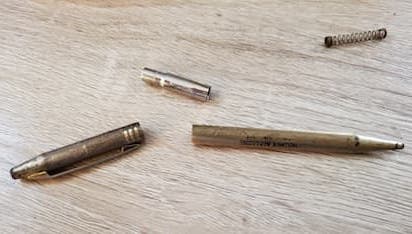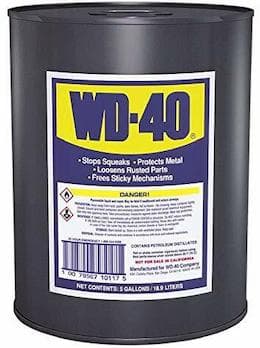
-----
Aluminum threads stuck, cold welded
Q. Hi All,
Not sure if this is the place to post, but I wanted to know if I'm wasting my time with this project.
I've got a vintage chromatic pen that I found in an old tool box I bought.
The pen is a twist pen and upon trying to disassemble it because it was non functional, I could see that the top half houses the twist mechanism. The barrel connecting the two halves is steel.
I originally thought the mechanism was plastic because I was able to thread a bolt into it. After I couldn't pull the mechanism out, I unthreaded the bolt and revealed aluminum.
The question here is, given the aluminum mechanism has bonded itself to the corroding brass, is there any way to un-bond them?


It's a nice brass pen, made in USA, but if this is a waste of time I'd like to know.
Thanks!
Isaac
- St. Clair Shores, Michigan
June 26, 2021
A. Hi Isaac. It's a very common problem: hoses with aluminum ends needing to be cut off of brass faucets is a commonplace. Actually, the brass doesn't have too much to do with it -- the aluminum corrodes and causes the problem.
Some people have reported success with WD-40 ⇦ on eBay or Amazon [affil link] or similar products plus the patience to wait a couple of days ... but no guarantees.
Luck & Regards,

Ted Mooney, P.E. RET
Striving to live Aloha
finishing.com - Pine Beach, New Jersey
Ted is available for instant help
or longer-term assistance.
⇩ Related postings, oldest first ⇩
Q. I'm hoping one of the experts here can offer some advice. I have a pair of aluminum rings that thread together to hold a filter on the front of a camera. Lack of care by the previous owner caused them to freeze together. These rings are about 4" in diameter, .2" high, and turned to about a .075 - .090 thickness, so any heavy force is likely to bend them out of round. They appear to be a hard, stiff alloy like 5000 or 6000 series with hard black anodizing. As a professional camera part, the threads are very fine, the fit is very close, and the surface finish makes a Rolex [affil link] look cheap. There is knurling on the outside of each ring intended to provide a grip to separate them. Turning by hand will not break them loose. Usually, the manufacturer uses a bayonet fitting instead of threads, or makes one part out of brass, but not this time. Any thoughts on how I might separate them?
My first attempt was to spray some WD-40 into the joint and let it soak. No effect. I also tried heating the outer ring with a hair dryer, but that didn't help either, as it wasn't possible to get much of a temperature differential between the two rings.
My next thought would be something like Liquid Wrench ⇦ on eBay or Amazon [affil link] -- but I thought I'd get some advice first. There is paint in engraved lettering on the rings I'd like to keep, so really strong solvents would be a last resort.
Any thoughts?
Robert Bleidt- Santa Clara, California, USA
2003
A. Hi, Robert. When it comes to aluminum-to-aluminum galling I've pretty much given up trying to light candles, and resigned myself to cursing the darkness. After a lifetime of broken bulbs because the bases are aluminum, hacksawing of frozen aluminum hose couplings, aluminum keys stuck in locks, and a dozen similar petty aggravations: If it has a thread or a moving part and it's aluminum, I don't want it.
The manufacturers may disagree with me but I've never seen a big difference between WD-40 ⇦ on eBay or Amazon [affil link] and Liquid Wrench ⇦ on eBay or Amazon [affil link] , so I don't think the Liquid Wrench is going to be your salvation.
I hope you prove me wrong, but my prediction is that filter ring is coming off only with a hacksaw.

Ted Mooney, P.E.
Striving to live Aloha
finishing.com - Pine Beach, New Jersey
Ted is available for instant help
or longer-term assistance.
A. Just a thought. No guarantees ! Try to determine which of the parts has the female threads. Once that has been determined, put the parts in your freezer for a couple of hours until they get as cold as they can get. Warm a hot plate or similar item (stove burner if electric)and after removing the parts from the freezer, immediately place the female part of the connection on the warm element for a few seconds then quickly try to unthread them. This may take several attempts to get the temperature differential just right. Good luck.
Bill Miller- Shinnston, West Virginia
Q. I was away on a trip for several days, and had left the WD-40 ⇦ on eBay or Amazon [affil link] on the part. Today I picked it up and it unscrewed like it had never been frozen, without any effort at all. Last week, I would have bet that the wall of the part would snap before the threads came loose. Apparently, 4-5 days of soaking had an effect.
Any suggestions on how I might keep this from happening again? I was thinking of some sort of lubricant or anti-seize product. WD-40 ⇦ on eBay or Amazon [affil link] seems to have done the job, but it tends to migrate away from the area it was applied, and could get on the lens. Cleaning a $3000 lens is a serious matter, and you're limited to sodium lauryl sulphate, methanol [affil link], or acetone ⇦ on eBay or Amazon [affil link] Flammable! as solvents.
Robert Bleidt- Santa Clara, California, USA
2003
A. Find a local anodizer and ask them to do the following:
1) Measure the anodic thickness to determine whether hard or conventional ( MIL-A-8625 / MIL-PRF-8625
[⇦ this spec on DLA] Type II) anodize.
2) Soak clean (ultrasonic if available) to remove WD-40.
3) Mask the lettering area with a tape resistant to step 4).
4) Remove any corrosion in the threads (and the unprotected anodize) using hot chromic acid-phosphoric acid solution per ASTM B137. It may take longer than usual due to limited diffusion, but this solution should not harm the aluminum.
5) Re-anodize* the separated parts, dye and seal.
6) Remove masking and touch-up if necessary.
*Owing to the thinness of the parts and uncertain alloy, perhaps do Type II anodizing regardless of initial anodize.
Ken Vlach [deceased]- Goleta, California
Rest in peace, Ken. Thank you for your hard work which the finishing world, and we at finishing.com, continue to benefit from.
![]() Surprised and happy to hear that it came apart after 4 days of WD-40
⇦ on
eBay
or
Amazon [affil link]
!
Surprised and happy to hear that it came apart after 4 days of WD-40
⇦ on
eBay
or
Amazon [affil link]
!

Ted Mooney, P.E.
Striving to live Aloha
finishing.com - Pine Beach, New Jersey
Ted is available for instant help
or longer-term assistance.
A. Robert,
Interesting reading re. galling!
To prevent this happening again, here are two ideas.
1. Use teflon tape ... then they'll never freeze together.
2. Get some molyslip ... but because it is very viscous, dilute with an appropriate solvent such as methonol, but not acetone. And if you're short of methanol, use Vodka or Canadian Club !
I used to keep a hypodermic (a glass one!) filled with this ... highly useful for getting into awkward places in order to lubricate them pdq.

Freeman Newton [dec.]
R.I.P. old friend (It is our sad duty to
advise that Freeman passed away 4/21/12)
2003
Multiple threads merged: please forgive chronology errors and repetition 🙂
Will Loctite prevent galling/seizing in tapped aluminum threads?
Q. I am installing 304 fasteners in a cast aluminum, high vibration situation. I need to know how to prevent galling and also prevent the bolts from backing out without the use of lock washers. Will LOCTITE prevent galling?
Sonny Smoyerpaints - Frederick, Maryland
2003
A. There are many kinds of Loctite as well as numerous similar products from the competition. Prevent galling, probably not. Reduce galling, yes. The degree will depend on many factors that you have not given.
James Watts- Navarre, Florida
2003
![]() Hi Sonny. My personal experience, not based on scientific study, is that threads in aluminum are almost always bad news: light bulbs stuck in sockets, hoses that won't unscrew from faucets, aluminum keys that won't come out of locks ... I think James is exactly right that the Loctite may be useful but is no guarantee. If you want it right, see if you can figure out a nut and bolt arrangement with nyloc nuts instead of the tapped aluminum. Good luck.
Hi Sonny. My personal experience, not based on scientific study, is that threads in aluminum are almost always bad news: light bulbs stuck in sockets, hoses that won't unscrew from faucets, aluminum keys that won't come out of locks ... I think James is exactly right that the Loctite may be useful but is no guarantee. If you want it right, see if you can figure out a nut and bolt arrangement with nyloc nuts instead of the tapped aluminum. Good luck.
Regards,

Ted Mooney, P.E.
Striving to live Aloha
finishing.com - Pine Beach, New Jersey
Ted is available for instant help
or longer-term assistance.
A. Hi, you can use Loctite or you can buy fasteners with Butanone pre-applied to them. You can reuse them up to 5 times. There is some more information about them here: www.accu.co.uk/en/p/45-thread-locking-patches.
Harry
Engineering - Sheffield, Yorkshire
June 10, 2019
April 10, 2011
Q. A few years ago I acquired a fairly large (6 inches dia.) astronomical telescope that was made of aluminum. It had a pretty heavy brass screw-on lens cap. After playing with it for a while, I put the cap on and sat it in the garage. A few years later, now I decided to get it out but the brass cap is stuck on--hard! I don't want to pound, heat, or otherwise abuse it and hurt the expensive lens. Is there any way to dissolve the aluminum oxide, or whatever it is, so I can get the cap off? Is there any other method? Thanks
Bill HankinsHobbyist - Tuscaloosa, Alabama USA
A. Hi, Bill. Maybe you'll get lucky like Robert did. Put the WD-40 ⇦ on eBay or Amazon [affil link] or Liquid Wrench on and wait several days. Good luck.
Regards,

Ted Mooney, P.E.
Striving to live Aloha
finishing.com - Pine Beach, New Jersey
Ted is available for instant help
or longer-term assistance.
April 11, 2011
Brass spray nozzle stuck on an aluminum hose end
Q. My brass nozzles get so tight on a hose end that is aluminum, I can't unscrew them. Why? And what can I do about them?
Thanks for your reply.
- Queen Creek, Arizona USA
June 23, 2020
A. The first thing I'd do is take note of the brand name of your hose and make a pledge to yourself to never buy anything from that company again :-)
Because every engineer knows full well the curse they are laying upon the user when they specify aluminum instead of brass hose ends; it wasn't an error, it was a choice -- and that it was done solely in the name of cheap is bad enough ... but if they colored them yellow to deliberately deceive you, there ought to be a law, but there isn't.
At this point, try WD-40
⇦ on
eBay
or
Amazon [affil link]
and patience. Apply it, tap-tap-tap, do the same several days in a row, then some channel locks or vice grips. Next time you can try a thread lubricant and hope for the best, but as a guy who has had to carefully hacksaw aluminum hose ends off of hose bibs, and who wasn't able to ever find a King Arthur able to pull the aluminum key out of my garage door lock, I won't promise it :-)

Ted Mooney, P.E. RET
Striving to live Aloha
finishing.com - Pine Beach, New Jersey
Ted is available for instant help
or longer-term assistance.
June 24, 2020
! All garden hoses now are imported from the China and fitted with brass threads on the connection side to the house but brass threads are covered with an aluminum threaded connection to the house faucet. All new hoses are like this and Ace Hardware is no exception. These hoses have an aluminum connection pressed onto the brass fitting that is pressed into the hose. Wow. I am having a problem getting the hose off the faucet on the outside of the house. I finally got it off by cutting the aluminum.
Robert Majcher- Mesa, Arizona
November 6, 2020
![]() Thanks Robert. I wouldn't know if it's all hoses but it certainly seems to be most.
Thanks Robert. I wouldn't know if it's all hoses but it certainly seems to be most.
Luck & Regards,

Ted Mooney, P.E. RET
Striving to live Aloha
finishing.com - Pine Beach, New Jersey
Ted is available for instant help
or longer-term assistance.
November 2020
Q, A, or Comment on THIS thread -or- Start a NEW Thread
